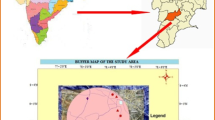Abstract
Spatial and temporal databases that integrate urban tree inventories and soil quality information are needed for modern-day sustainable urban forest management. The objective of this study was to demonstrate the usefulness of low-cost and widely-available technology, such as global positioning system (GPS)–enabled cameras to photo-document sites and cloud-based products and services (Google Picasa and Fusion Tables), to aid in developing sustainable street tree management programs. Google Fusion Tables provide a cloud platform to store, share and map urban tree and soil data over time using internet connected computers, tablets or mobile devices. Although indicators of urban soil quality and best methods to assess it are not yet standardized, we demonstrate here promising indicators that are both useful and easy to incorporate into spatial and temporal databases of trees managed in urban environments. By utilizing technology, we demonstrate that site-specific urban soil quality indicators can be used together with readily-available soil rating systems specific to different plant types as a means to better evaluate and manage conditions for optimal street tree growth and health.






Similar content being viewed by others
References
Bowie GD, Millward AA, Bhagat NN (2014) Interactive mapping of urban tree benefits using google fusion tables and API technologies. Urban For Urban Green (In press). http://dx.doi.org/10.1016/j.ufug.2014.06.002
Cekstere G, Osvalde A (2013) A study of chemical characteristics of soil in relation to street trees status in Riga (Latvia). Urban For Urban Green 12:69–78
Clemson University Agricultural Service Laboratory (2014) Agricultural service laboratory soil testing results. Retrieved on July 29, 2014 at http://psaweb.clemson.edu/soils/htdocs/understandingreport.pdf
Craul PJ (1999) Urban soils: applications and practices. John Wiley and Sons
Czerniawska-Kusza I, Kusza G, Dużyński M (2004) Effect of deicing salts on urban soils and health status of roadside tres in the Opole region. Environ Toxicol 19:296–301
DE Kimpe CR, Morel JL (2000) Urban soil management: a growing concern. Soil Sci 165:31–40
Doran JW, Parkin TB (1996) Quantitative indicators of soil quality: a minimum data set. In: Methods for assessing soil quality. J. W. Doran and A. J. Jones, Soil Science Society of America Inc, Madison, USA, pp. 25–37
Hardy DH, Myers J, Stokes C (2008) Heavy metals in North Carolina soils – significance and occurrence. N.C. Department of Agriculture and Consumer Services Retrieved July 29, 2014 from http://www.ncagr.gov/agronomi/pdffiles/hmetals.pdf
Jaenson R, Bassuk N, Schwager S, Headley D (1992) A statistical method for the accurate and rapid sampling of urban street tree populations. J Arboric 18:171–183
James P, Tzoulas K, Adams M, Barber A, Box J, Breuste J, Elmqvist T, Frith M, Gordon C, Greening K, Haworth S, Kazmierczak A, Johnston M, Korpela K, Moretti M, Niemela J, Pauleit S, Roe M, Sadler J, Ward Thompson C (2009) Towards an integrated understanding of green space in the European built environment. Urban For Urban Green 8:65–75
Jim CY (1998) Physical and chemical properties of a Hong Kong roadside soil in relation to urban tree growth. Urban Ecosystems 2:171–181
Keydoszius JR, Cox SK, Haque MB, Mikhailova EA, Post CJ, Stringer WC, Schlautman MA (2007) Historical land use and soil analysis guiding corridor landscape design. Urban Ecosystems 10:53–72
Koeser A, Hauer R, Norris K, Krouse R (2013) Factors influencing long-term street tree survival in Milwaukee, WI, USA. Urban For Urban Green 12:562–568
Koeser AK, Gilman EF, Paz M, Harchick C (2014) Factors influencing urban tree planting program growth and survival in Florida, United States. Urban Forestry & Urban Greening (In press) http://dx.doi.org/10.1016/j.ufug.2014.06.005
Kratsch H (2012). Boron- and salt-tolerant trees and shrubs for Northern Nevada. University of Nevada Cooperative Extension Special Publication 12–04.
Makarushka M (2012) Detroit's vacant lots provide ‘natural laboratory’ for studying soil processes. Soil Horizons. doi:10.2136/sh2012-53-2-lf
Murdock L, Gray T, Higgins F, Wells K (1995) Soil compaction in Kentucky. Cooperative Extension Service, University of Kentucky, AGR-161.
Ordónez C, Duinker PN (2013) An analysis of urban forest management plans in Canada: implications for urban forest management. Landsc Urban Plan 116:36–47
Pickett STA, Cadenasso ML, Grove JM, Nilon CH, Pouyat RV, Zipperer WC, Costanza R (2001) Urban ecological systems: linking terrestrial ecological, physical, and socioeconomic components of metropolitan areas. Annu Rev Ecol Syst 32:127–157
Scharenbroch BC, Catania M (2012) Soil quality attributes as indicators of urban tree performance. Arboricult Urban For 38:214–228
Scheyer JM, Hipple KW (2005) Urban Soil primer. United States Department of agriculture, Natural resources conservation service, National soil survey center, Lincoln, Nebraska (http://soils.usda.gov/use).
Soil Survey Staff, Natural Resources Conservation Service, United States Department of Agriculture (2014) Web soil survey. Available online at http://websoilsurvey.nrcs.usda.gov/. Accessed [07/24/2014].
USDA (1999) Soil quality test kit guide. United States Department of agriculture, agricultural research service and natural resources conservation service-soil quality institute. Web page, accessed 17 July, 2014. (reference: soils.usda.gov/sqi/kit2.html)
Vrščaj B, Poggio L, Marsan FA (2008) A method for soil environmental quality evaluation for management and planning in urban areas. Landsc Urban Plan 88:81–94
Ward KT, Johnson GR (2007) Geospatial methods provide timely and comprehensive urban forest information. Urban For Urban Green 6:15–22
Acknowledgments
This research was made possible with funding from the City of Clemson, SC and the Clemson University Creative Inquiry Program. Technical assistance was provided by Tony Tidwell, and Jamaal Alston aided with field data collection. This is technical Contribution No. 6240 of the Clemson University Experiment Station. This material is based upon work supported by NIFA/USDA, under project number SC-1700452.
Author information
Authors and Affiliations
Corresponding author
Electronic supplementary material
APPENDIX Table 1
(DOC 72.5 kb)
APPENDIX Table2
(DOC 93.5 kb)
APPENDIX Table 3
(DOC 77.5 kb)
APPENDIX Fig. 1
Screen capture of an example of urban soil analysis report with lime and fertilizer recommendations from Clemson University Agricultural Service Laboratory. (DOC 182 kb)
Rights and permissions
About this article
Cite this article
Green, L.Y., Mikhailova, E.A., Post, C.J. et al. A cloud-based spatial-temporal inventory for sustainable urban soil management. Urban Ecosyst 19, 811–822 (2016). https://doi.org/10.1007/s11252-015-0512-2
Published:
Issue Date:
DOI: https://doi.org/10.1007/s11252-015-0512-2




